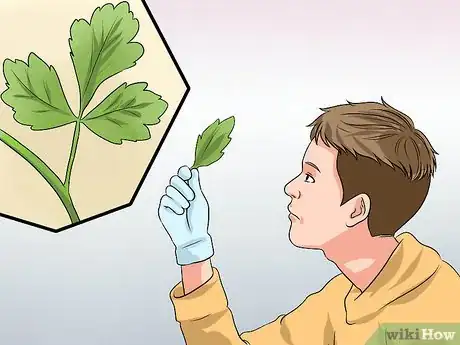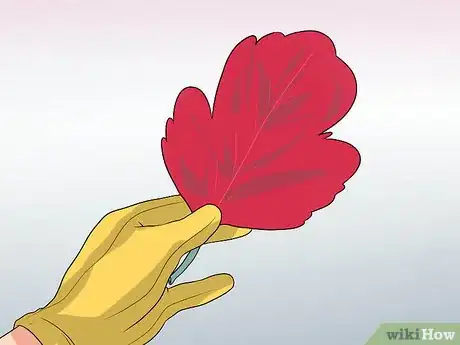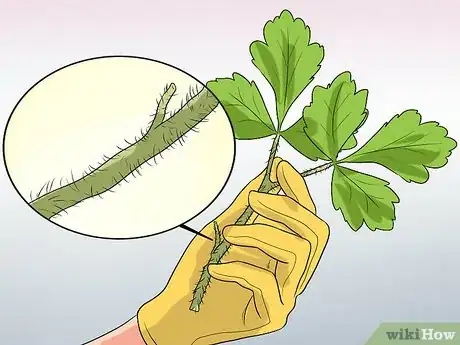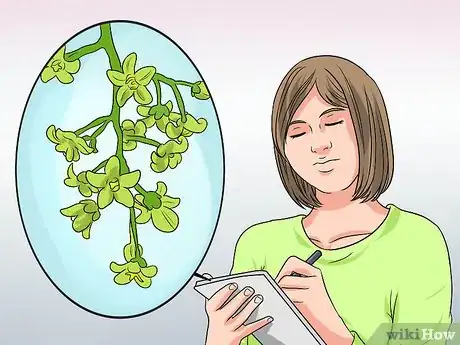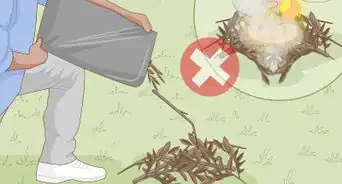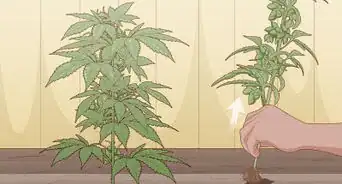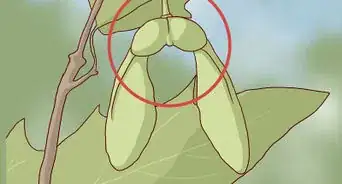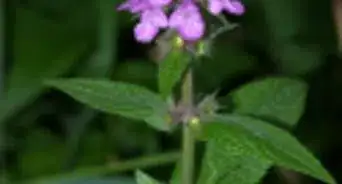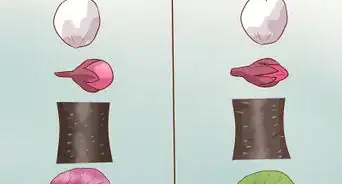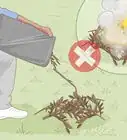This article was co-authored by Alan O. Khadavi, MD, FACAAI. Dr. Alan O. Khadavi is a Board Certified Allergist and a Pediatric Allergy Specialist based in Los Angeles, California. He holds a BS in biochemistry from the State University of New York (SUNY) at Stony Brook and an MD from the State University of New York Health Science Center at Brooklyn. Dr. Khadavi completed his pediatric residency at Schneider Children’s Hospital in New York, and then went on to complete his allergy and immunology fellowship and pediatric residency at Long Island College Hospital. He is board certified in adult and pediatric allergy/immunology. Dr. Khadavi is a Diplomate of the American Board of Allergy and Immunology, a Fellow of the American College of Allergy, Asthma & Immunology (ACAAI), and a member of the American Academy of Allergy, Asthma & Immunology (AAAAI). Dr. Khadavi's honors include Castle Connolly’s list of Top Doctors 2013-2020, and Patient Choice Awards "Most Compassionate Doctor" in 2013 & 2014.
There are 14 references cited in this article, which can be found at the bottom of the page.
wikiHow marks an article as reader-approved once it receives enough positive feedback. In this case, 86% of readers who voted found the article helpful, earning it our reader-approved status.
This article has been viewed 329,049 times.
Hiking or being in nature is enjoyable, but exposure to poison oak causes a very itchy, blistery rash that will quickly put a damper on your fun. The leaves of this plant have a recognizable appearance if you know what to look for. If you haven’t ever been exposed to poison oak, there are ways to prevent poison oak exposure through plant identification.
Steps
Finding Poison Oak
-
1Learn about poison oak. Poison oak is similar to its close relatives poison ivy and poison sumac because they are all members of the same botanical family. The most common type of poison oak, known as western poison oak, grows most commonly along the Pacific coast in Oregon, Washington, and California. It can grow as a small shrub in open spaces or as a climbing vine in shaded forest areas.[1]
- Other varieties of poison oak include Atlantic poison oak, which grows in the southeast US. This variety is much less common than the western poison oak.[2]
-
2Be careful when examining the plant. A good way to avoid a poison oak rash is to never touch a plant that you think may be poison oak. In order to get close enough to the plant to identify it, use a stick or a gloved hand to examine it more closely.
- If it turns out to be poison oak, make sure anything that has come into contact with the plant is washed with soap and water.
Advertisement -
3Look at the leaves. Poison oak, whether it is growing as a shrub or a climbing vine, has a trifoliate leaf structure. This means that the leaves grow in sets of threes off the stem. The edges of the leaves have a wavy or scalloped appearance.
- As the name suggests, the leaves look a bit like oak leaves.[3]
-
4Check the color. The top side of the leaves are typically a glossy green color. They can also be yellowish, reddish, or brownish depending on the health of the plant and the season. On the underside of the leaf, there is less sheen, less green, and more of a velvety appearance.[4]
-
5Examine the stems. Stems tend to be a bit greyish in color, though, given the lighting in some forested areas, this can be difficult to see. The stems will also be covered in tiny hair or thorn-like structures.[5]
-
6Take note of the flowers or berries. Poison oak has yellowish-green small flowers in the spring. The plant will also produce light green berries throughout the summer and into the fall.[6]
- This will help you rule out other plants by noting what it doesn’t have. If it doesn’t have pointed leaves and it doesn’t have thorns, it isn’t poison oak.
-
7Learn other forms of poison oak.[7]
- In the winter, it loses its leaves and looks like reddish-brown sticks (sometimes a few poking up from the ground, sometimes a big clump) with alternating stubs.
- You can also find it as a thick vine climbing up a tree, sometimes (depending on the season) with small poison oak leaves coming out of it.
Recognizing the Poison Oak Rash
-
1Learn what causes the rash. Both the leaves and the stems of poison oak contain urushiol, an oily plant substance that triggers an allergic reaction in the form of the poison oak rash. Urushiol can also be found in the roots and even in the dead plant.[8]
- In addition, urushiol can become airborne if the plant is burned and is easily transported from one object to another.
- The rash from poison oak is not contagious in the standard sense, but if someone has the urushiol on their hands and touches another person, that second person can react as well.
- All parts of the poison oak plant contain the toxin urushiol. Even when the leaves fall off in winter, the plant is not safe to touch.[9]
-
2Recognize the rash. A rash from exposure to poison oak can vary depending on the person because some people are more sensitive to urushiol than others. In general, the rash will be very itchy and very red, with red bumps that may blister and ooze fluids.[10] The rash can be streaky and patchy and can range from relatively mild to very severe.[11]
-
3
-
4Relieve the itching. In order to help relieve the itching of the rash, apply calamine lotion to the site.[14] You can also apply topical steroids such as clobetasol or systemic steroids and antihistamines.[15] Also try a cold compress or an oatmeal bath.[16]
- To make an oatmeal bath, pour two cups of oatmeal into a nylon sock or stocking and tie it onto the tap so that warm bath water runs through the oatmeal. Soak in the tub or soak the affected areas for at least 30 minutes.
- You can also use baking soda in a warm bath.[17]
-
5Keep the rash from spreading to others. Be aware that urushiol can be easily passed to another person, animal, or object. Make sure anything or anybody that may have come into contact with poison oak is carefully washed with soap and water.[18]
- Most rashes will heal in five to 12 days, but the rash can last as long as a month or more.[19]
-
6Seek medical help. Call emergency services if the reaction to the poison oak is severe. You should also call is you or the infected the person has trouble swallowing, breathing, or has severe swelling at the site of contact or anywhere on the body.[20]
Expert Q&A
Did you know you can get expert answers for this article?
Unlock expert answers by supporting wikiHow
-
QuestionWhat does a poison oak rash look like?
 Alan O. Khadavi, MD, FACAAIDr. Alan O. Khadavi is a Board Certified Allergist and a Pediatric Allergy Specialist based in Los Angeles, California. He holds a BS in biochemistry from the State University of New York (SUNY) at Stony Brook and an MD from the State University of New York Health Science Center at Brooklyn. Dr. Khadavi completed his pediatric residency at Schneider Children’s Hospital in New York, and then went on to complete his allergy and immunology fellowship and pediatric residency at Long Island College Hospital. He is board certified in adult and pediatric allergy/immunology. Dr. Khadavi is a Diplomate of the American Board of Allergy and Immunology, a Fellow of the American College of Allergy, Asthma & Immunology (ACAAI), and a member of the American Academy of Allergy, Asthma & Immunology (AAAAI). Dr. Khadavi's honors include Castle Connolly’s list of Top Doctors 2013-2020, and Patient Choice Awards "Most Compassionate Doctor" in 2013 & 2014.
Alan O. Khadavi, MD, FACAAIDr. Alan O. Khadavi is a Board Certified Allergist and a Pediatric Allergy Specialist based in Los Angeles, California. He holds a BS in biochemistry from the State University of New York (SUNY) at Stony Brook and an MD from the State University of New York Health Science Center at Brooklyn. Dr. Khadavi completed his pediatric residency at Schneider Children’s Hospital in New York, and then went on to complete his allergy and immunology fellowship and pediatric residency at Long Island College Hospital. He is board certified in adult and pediatric allergy/immunology. Dr. Khadavi is a Diplomate of the American Board of Allergy and Immunology, a Fellow of the American College of Allergy, Asthma & Immunology (ACAAI), and a member of the American Academy of Allergy, Asthma & Immunology (AAAAI). Dr. Khadavi's honors include Castle Connolly’s list of Top Doctors 2013-2020, and Patient Choice Awards "Most Compassionate Doctor" in 2013 & 2014.
Board Certified Allergist
References
- ↑ https://www.aces.edu/blog/topics/forestry/touch-me-nots-poison-ivy-poison-oak-and-poison-sumac/
- ↑ http://www.cdc.gov/niosh/topics/plants/
- ↑ http://www.cdc.gov/niosh/topics/plants/
- ↑ https://www.fda.gov/consumers/consumer-updates/outsmarting-poison-ivy-and-other-poisonous-plants
- ↑ https://www.openspace.org/where-to-go/nature/poison-oak
- ↑ https://edis.ifas.ufl.edu/publication/EP220
- ↑ https://www.parksconservancy.org/park-e-ventures-article/four-season-field-guide-poison-oak
- ↑ https://my.clevelandclinic.org/health/diseases_conditions/hic_Contact_Dermatitis/hic_The_Poison_Plants_Poison_Ivy_Poison_Oak_and_Poison_Sumac
- ↑ https://www.fda.gov/consumers/consumer-updates/outsmarting-poison-ivy-and-other-poisonous-plants
- ↑ Alan O. Khadavi, MD, FACAAI. Board Certified Allergist. Expert Interview. 26 August 2020.
- ↑ https://www.cdc.gov/niosh/topics/plants/symptoms.html
- ↑ https://www.nlm.nih.gov/medlineplus/ency/article/000027.htm
- ↑ https://www.aad.org/dermatology-a-to-z/diseases-and-treatments/m---p/poison-ivy/tips
- ↑ Alan O. Khadavi, MD, FACAAI. Board Certified Allergist. Expert Interview. 26 August 2020.
- ↑ Alan O. Khadavi, MD, FACAAI. Board Certified Allergist. Expert Interview. 26 August 2020.
- ↑ https://health.clevelandclinic.org/the-best-home-remedies-for-poison-ivy/
- ↑ https://www.aad.org/dermatology-a-to-z/diseases-and-treatments/m---p/poison-ivy/tips
- ↑ https://www.aad.org/dermatology-a-to-z/diseases-and-treatments/m---p/poison-ivy/tips
- ↑ https://www.aad.org/dermatology-a-to-z/diseases-and-treatments/m---p/poison-ivy/tips
- ↑ https://my.clevelandclinic.org/health/articles/10655-poison-plants-poison-ivy--poison-oak--poison-sumac
About This Article
Poison oak can grow as a vine or a shrub, and it has glossy green leaves that usually grow in sets of three. The leaves resemble oak leaves, but poison oak actually isn’t a member of the oak family. Depending on the season, the leaves may also be yellow, red, or brown. Poison oak may have small yellow or green flowers during the spring and green-yellow or white berries during the summer and fall. Poison oak is most commonly found along the Pacific Coast of the U.S., but it’s also sometimes found in the southeastern U.S. Avoid touching poison oak since the leaves and stems contain an oily substance that can cause an unpleasant rash. Wash anything that comes into contact with poison oak using soap and water. If you experience swelling, difficulty breathing, or difficulty swallowing after coming in contact with poison oak, get emergency medical care. For tips from our Physician reviewer on how to tell if you have a poison oak rash, read on!


